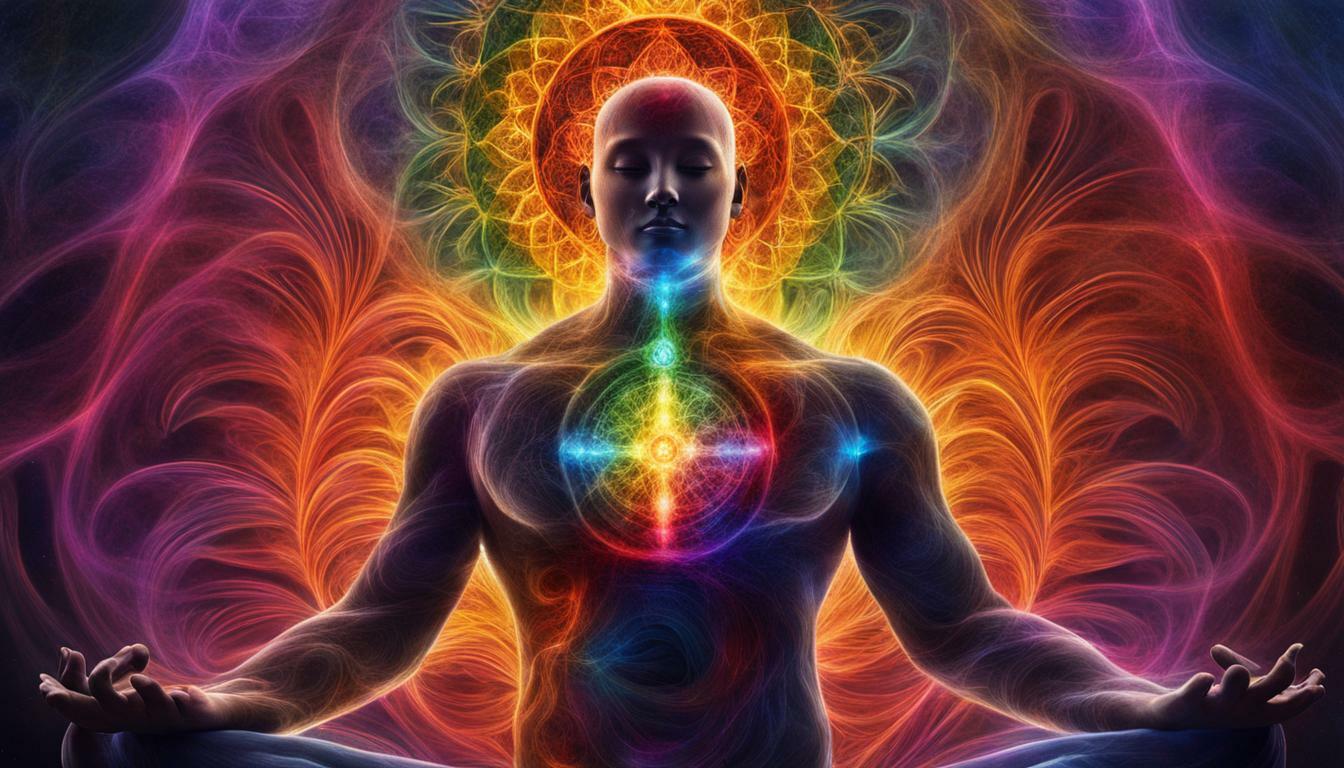Chakras are energy centers in the body that play a vital role in maintaining overall well-being. They are like spinning wheels of energy that correspond to different organs and nerve bundles. Understanding how chakras work can provide a framework for achieving balance and harmony in your mind and body.
Key Takeaways:
- Chakras are energy centers in the body that promote physical, mental, and emotional well-being.
- There are seven main chakras along the spine, each associated with specific qualities and functions.
- Blocked or unbalanced chakras can lead to physical or emotional symptoms.
- Practices like yoga, breathing exercises, and meditation can help unblock and balance chakras.
- While chakras have not been extensively studied in medical research, they can offer a holistic approach to understanding the mind-body connection.
The Seven Main Chakras and Their Functions
Each of the seven main chakras, from the root to the crown, has its unique role in the energy flow within your body. Understanding how these chakras function can provide valuable insights into your physical, mental, and emotional well-being.
Starting at the base of your spine is the root chakra. This chakra is associated with stability, grounding, and a sense of belonging. When balanced, it promotes feelings of security and supports physical health.
Moving up, we come to the sacral chakra, located in the lower abdomen. This chakra governs creativity, sensuality, and emotional well-being. When in balance, it fosters healthy relationships and encourages the free flow of emotions.
The solar plexus chakra, located in the upper abdomen, is responsible for confidence, personal power, and self-esteem. It plays a key role in our ability to make decisions and take action. A balanced solar plexus chakra promotes a strong sense of self and empowerment.
Next, we have the heart chakra, located in the center of the chest. This chakra is associated with love, compassion, and forgiveness. When balanced, it enables us to form deep connections with ourselves and others, fostering emotional healing and harmonious relationships.
The throat chakra, as the name suggests, resides in the throat area. It influences communication, self-expression, and authenticity. A balanced throat chakra allows for clear and honest communication, empowering us to speak our truth and be heard.
The third eye chakra, located between the eyebrows, is associated with intuition, insight, and higher consciousness. When balanced, it enhances our ability to trust our inner wisdom, make clear decisions, and tap into our spiritual selves.
Finally, we have the crown chakra, situated at the top of the head. This chakra connects us to the divine and our higher self. It governs our spiritual awareness, wisdom, and sense of purpose. When balanced, it brings a sense of alignment, enlightenment, and a deeper understanding of the universe.
| Chakra | Location | Function |
|---|---|---|
| Root Chakra | Base of the spine | Stability, grounding, security |
| Sacral Chakra | Lower abdomen | Creativity, sensuality, emotional well-being |
| Solar Plexus Chakra | Upper abdomen | Confidence, personal power, self-esteem |
| Heart Chakra | Center of the chest | Love, compassion, forgiveness |
| Throat Chakra | Throat area | Communication, self-expression, authenticity |
| Third Eye Chakra | Between the eyebrows | Intuition, insight, higher consciousness |
| Crown Chakra | Top of the head | Spiritual awareness, wisdom, sense of purpose |
Each of the seven main chakras is vital to maintaining a harmonious energy flow within your body. By understanding their functions, you can begin to bring awareness to areas that may need balancing and work towards achieving overall well-being.
Signs of Blocked or Unbalanced Chakras
When a chakra is blocked or unbalanced, it can manifest in various ways, affecting both your physical and emotional well-being. By understanding these signs, you can identify which chakras may need attention and take steps to restore balance.
Root Chakra (Muladhara)
The root chakra, located at the base of the spine, governs your sense of security, stability, and grounding. When it is blocked or unbalanced, you may experience feelings of fear, insecurity, or a lack of confidence in yourself or the world around you. Physical symptoms may include lower back pain, constipation, or issues with your legs and feet.
Sacral Chakra (Svadhishthana)
The sacral chakra, found in the lower abdomen, is connected to your emotions, creativity, and sexuality. An imbalance in this chakra can result in a lack of passion, creativity, or difficulties in forming and maintaining intimate relationships. Physical symptoms may include lower abdominal pain, reproductive issues, or urinary problems.
Solar Plexus Chakra (Manipura)
The solar plexus chakra, located in the upper abdomen, is associated with your personal power, self-esteem, and confidence. When this chakra is blocked or unbalanced, you may struggle with low self-esteem, lack of motivation, or difficulty in setting boundaries. Physical symptoms may include digestive issues, stomach ulcers, or poor digestion.
Heart Chakra (Anahata)
The heart chakra, located in the center of the chest, governs love, compassion, and emotional well-being. An imbalanced heart chakra can result in difficulties in giving or receiving love, feelings of isolation, or an inability to connect with others on a deep level. Physical symptoms may include heart problems, respiratory issues, or circulation problems.
| Chakra | Signs of Blockage/Imbalance | Physical Symptoms |
|---|---|---|
| Root Chakra | Fear, insecurity, lack of confidence | Lower back pain, constipation, leg/foot issues |
| Sacral Chakra | Lack of passion, creativity, difficulties in relationships | Lower abdominal pain, reproductive/urinary issues |
| Solar Plexus Chakra | Low self-esteem, lack of motivation, difficulties setting boundaries | Digestive issues, stomach ulcers, poor digestion |
| Heart Chakra | Difficulties in giving/receiving love, feelings of isolation | Heart problems, respiratory issues, circulation problems |
Throat Chakra (Vishuddha)
The throat chakra, located in the throat area, is associated with communication, self-expression, and speaking your truth. An imbalanced throat chakra can result in difficulties in expressing yourself, fear of speaking up, or problems with communication. Physical symptoms may include sore throat, thyroid issues, or neck pain.
Third Eye Chakra (Ajna)
The third eye chakra, situated between the eyebrows, is connected to intuition, insight, and higher consciousness. When this chakra is blocked or unbalanced, you may experience difficulties in trusting your intuition, making decisions, or connecting with your inner wisdom. Physical symptoms may include headaches, vision problems, or issues with the sinuses.
Crown Chakra (Sahasrara)
The crown chakra, located at the top of the head, represents spiritual connection, enlightenment, and divine consciousness. An imbalanced crown chakra can result in feelings of disconnection from spirituality, lack of purpose, or an inability to find meaning in life. Physical symptoms may include migraines, dizziness, or issues with the central nervous system.
By recognizing these signs of blocked or unbalanced chakras, you can take steps to restore harmony and promote overall well-being. Remember that chakras and the concept of energy centers in the body are not based on scientific evidence, but they can serve as a useful framework for understanding the mind-body connection and achieving balance in your life.
Methods for Chakra Balancing and Healing
There are several effective methods you can use to balance and heal your chakras, promoting optimal energy flow throughout your body. These practices can help you restore harmony and well-being, allowing you to feel more balanced and grounded. Remember, it’s important to consult with a healthcare professional before starting any new wellness practices.
Yoga Poses
Yoga poses are a popular and effective way to balance and activate your chakras. Each pose targets specific chakras, helping to release any blockages and restore energy flow. For example, the “Tree Pose” is excellent for grounding and activating the root chakra, while the “Fish Pose” can open and stimulate the throat chakra. Incorporating a variety of poses into your practice will ensure all your chakras receive attention and care.
Breathing Exercises
Deep, conscious breathing exercises are another powerful tool for chakra healing. By focusing on your breath, you can channel energy into specific chakras, promoting balance and vitality. One simple yet effective breathing exercise is alternate nostril breathing. Sit comfortably, close one nostril with your thumb, inhale deeply through the open nostril, then close it with your index finger and exhale through the other nostril. Repeat this process, alternating nostrils with each breath. This exercise helps balance both the energy and the flow of breath in your body.
Meditation
Meditation is a cornerstone practice for chakra healing. By quieting the mind and turning your attention inward, you can connect with and balance your chakras on a deeper level. Guided chakra meditations are especially helpful for beginners, as they provide specific visualizations and affirmations to activate and harmonize each chakra. Incorporating regular meditation into your routine can promote a sense of mental clarity, emotional well-being, and overall balance in your chakras.
| Chakra | Location | Qualities and Functions |
|---|---|---|
| Root Chakra | Base of the spine | Grounding, stability, security |
| Sacral Chakra | Lower abdomen | Creativity, passion, sexuality |
| Solar Plexus Chakra | Upper abdomen | Confidence, personal power, digestion |
| Heart Chakra | Chest | Love, compassion, emotional healing |
| Throat Chakra | Throat | Communication, self-expression |
| Third Eye Chakra | Forehead, between the eyebrows | Intuition, perception, clarity |
| Crown Chakra | Top of the head | Spirituality, connection to higher consciousness |
Remember, chakra healing and balancing are holistic practices, sensitive to individual experiences and beliefs. It’s essential to listen to your body and intuition as you explore these methods. By incorporating yoga poses, breathing exercises, and meditation into your routine, you can create a dedicated space for self-care, promote chakra balance, and enhance your overall well-being.
Chakra Meditation and Cleansing Practices
Incorporating chakra-focused meditation and cleansing practices into your routine can help clear blockages and restore balance to your energy centers. By connecting with the subtle energy of your chakras, you can promote a sense of harmony within your mind, body, and spirit.
One effective meditation practice for chakra healing is to visualize each chakra as a spinning wheel of colored light. Starting from the root chakra at the base of your spine, imagine a vibrant red energy swirling and expanding, grounding you to the earth. Gradually move your focus up through each chakra, envisioning their respective colors and qualities. Visualize any stagnant or blocked energy being released and replaced with pure, vibrant energy.
To further enhance the cleansing process, you can combine meditation with specific yoga poses that target each chakra. For example, the Cobra pose (Bhujangasana) can help activate and open the heart chakra, while the supported shoulder stand (Salamba Sarvangasana) can stimulate the throat and third eye chakras. As you move through each pose, focus your attention on the corresponding chakra, imagining the energy flowing freely and rejuvenating that area of your body.
It’s important to note that chakra cleansing is a personal practice, and what works for one individual may not resonate with another. Experiment with different techniques and find what feels most authentic and nourishing to you. Remember to listen to your body and honor its needs as you embark on your chakra healing journey.
| Chakra | Color | Qualities | Associated Yoga Poses |
|---|---|---|---|
| Root Chakra | Red | Grounding, stability | Mountain pose (Tadasana), Warrior I (Virabhadrasana I) |
| Sacral Chakra | Orange | Creativity, sensuality | Bound Angle pose (Baddha Konasana), Crescent Moon pose (Anjaneyasana) |
| Solar Plexus Chakra | Yellow | Confidence, personal power | Boat pose (Navasana), Warrior III (Virabhadrasana III) |
| Heart Chakra | Green | Love, compassion | Camel pose (Ustrasana), Bridge pose (Setu Bandha Sarvangasana) |
| Throat Chakra | Blue | Communication, self-expression | Shoulder stand (Sarvangasana), Fish pose (Matsyasana) |
| Third Eye Chakra | Indigo | Intuition, inner wisdom | Child’s pose (Balasana), Downward-Facing Dog (Adho Mukha Svanasana) |
| Crown Chakra | Purple | Spirituality, connection to the divine | Headstand (Sirsasana), Lotus pose (Padmasana) |
Remember that chakra meditation and cleansing practices are complementary to any existing medical or therapeutic treatments you may be undergoing. It’s essential to consult with a healthcare professional for any physical or emotional concerns you may have. The exploration of chakras and their potential benefits is an individual journey, and by integrating these practices into your routine, you can embark on a path of self-discovery and holistic well-being.
The Mind-Body Connection and Chakras
Exploring the intricate relationship between chakras and the mind-body connection can provide valuable insights into achieving holistic well-being. Chakras, the energy centers in your body, are believed to correspond to different organs and nerve bundles. There are seven main chakras, each associated with specific qualities and functions, running along your spine. When these chakras are in balance, they promote physical, mental, and emotional well-being.
If a chakra becomes blocked or unbalanced, it can result in various physical or emotional symptoms. For example, a blocked root chakra may manifest as feelings of insecurity or instability, while an imbalanced heart chakra might cause difficulties in forming and maintaining emotional connections. Recognizing and addressing these imbalances can help restore harmony to your overall well-being.
To unblock or balance your chakras, there are various practices you can incorporate into your daily routine. Yoga poses, such as the Child’s Pose or Tree Pose, can help stimulate and activate specific chakras. Breathing exercises, like alternate nostril breathing or deep belly breathing, can also aid in restoring energy flow to blocked chakras. Additionally, meditation, specifically focused on chakras, can cleanse and activate these energy centers.
| Chakra | Location | Function |
|---|---|---|
| Root Chakra | Base of the spine | Provides stability and a sense of security |
| Sacral Chakra | Lower abdomen | Associated with creativity and sexuality |
| Solar Plexus Chakra | Above the navel | Related to personal power and confidence |
| Heart Chakra | Center of the chest | Connected to love, compassion, and emotional healing |
| Throat Chakra | Throat area | Facilitates communication and self-expression |
| Third Eye Chakra | Between the eyebrows | Enhances intuition and inner wisdom |
| Crown Chakra | Top of the head | Associated with spiritual connection and enlightenment |
While the understanding of chakras and their influence on the body is not extensively studied in medical research, they can serve as a framework for understanding the mind and body connection. By recognizing and addressing imbalances in your chakras, you can take steps towards achieving overall wellness and harmony in your life.
Conclusion
Understanding how chakras work is an essential step toward enhancing your overall wellness and achieving spiritual balance. Chakras are energy centers in the body that correspond to different organs and nerve bundles, and when they are balanced, they promote physical, mental, and emotional well-being.
There are seven main chakras that run along the spine, including the root chakra, sacral chakra, solar plexus chakra, heart chakra, throat chakra, third eye chakra, and crown chakra. Each chakra is associated with specific qualities and functions, contributing to the overall harmony of the mind and body.
If a chakra becomes blocked or unbalanced, it can manifest as physical or emotional symptoms. However, there are various practices that can help unblock and balance chakras, such as yoga poses, breathing exercises, and meditation. These techniques can promote the flow of energy and restore harmony to the chakra system.
It’s important to note that while chakras provide a framework for understanding the mind-body connection, the belief in their influence on the body has not been thoroughly studied in medical research. Nonetheless, incorporating chakra-activating practices into your wellness routine can offer a holistic approach to self-care and provide a sense of spiritual balance.
What is the Relationship Between Manipura Chakra and Chakra Activation?
The relationship between Manipura Chakra and Chakra Activation is vital for achieving overall well-being. Chakra activation techniques, such as meditation and yoga, help to activate manipura chakra, located in the solar plexus area. When we actively work to activate Manipura Chakra, we enhance our self-esteem, personal power, and intuition, leading to a balanced and harmonious existence.
FAQ
Q: How do chakras work?
A: Chakras are energy centers in the body that correspond to different organs and nerve bundles. They promote physical, mental, and emotional well-being when balanced.
Q: What are the seven main chakras and their functions?
A: The seven main chakras are the root chakra, sacral chakra, solar plexus chakra, heart chakra, throat chakra, third eye chakra, and crown chakra. Each chakra is associated with specific qualities and functions.
Q: What are the signs of blocked or unbalanced chakras?
A: Blocked or unbalanced chakras can manifest as physical or emotional symptoms, indicating an imbalance in the body’s energy flow.
Q: How can I balance and heal my chakras?
A: There are various methods for chakra balancing and healing, including yoga poses, breathing exercises, and meditation. These practices can help restore harmony to the chakra system.
Q: What are some chakra meditation and cleansing practices?
A: Chakra meditation practices and cleansing exercises can help cleanse and activate your chakras. These techniques focus on channeling energy and promoting balance.
Q: What is the connection between chakras and the mind-body connection?
A: Understanding chakras can enhance the mind-body connection. Balanced chakras contribute to overall wellness and can support the body’s natural healing processes.
Q: How important is it to understand how chakras work?
A: While chakras and their influence on the body have not been thoroughly studied in medical research, understanding chakras can provide a framework for understanding the mind and body, promoting self-awareness and well-being.








